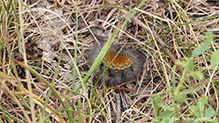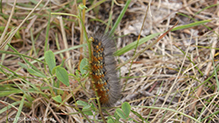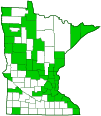salt marsh moth
(Estigmene acrea)
Conservation • Description • Habitat • Ecology • Distribution • Taxonomy
|
||||||||
| Hodges # | 8131 |
|||||||
Conservation Status |
||||||||
| IUCN Red List | not listed |
|||||||
| NatureServe | N5 - Secure |
|||||||
| Minnesota | not listed |
|||||||
Description |
||
Salt marsh moth is a common and widespread tiger moth. It occurs throughout the United States and southern Canada, and south into Central America. It is common in Minnesota. Adults are found in open areas, including open woodlands, prairies, meadows, agricultural fields, abandoned fields, and all kinds of marshes, including salt marshes. They are active from May to September in Minnesota. The larvae feed mostly on a wide variety of herbaceous plants, but also on the leaves of trees and shrubs. They are agricultural pests of many crops, including cabbage, cotton, walnuts, apple trees, tobacco, pea, potato, clovers, and maize. Adults are 1⅛″ (29 mm) in length and have a 1¾″ to 2⅝″ (45 to 68 mm) wingspan. The forewings are white above with five large black spots well-spaced along the leading edge (costal margin). There are also a few to many small, irregular, black spots along what would be the antemedial (AM), median, postmedial (PM), subterminal (ST), and terminal lines. On males, the underside of the forewing is sometimes tinted yellow or orangish-yellow, and the fringe is sometimes that color. On females the underside is white, sometimes with pale yellow tinting along the costal margin and the main veins. The fringe is always white. On males, the hindwings are dark yellow or yellowish-orange. On females, the hindwings are white. On both sexes, there are three or four black spots on the hindwing. On males, the underside of the thorax is orange. On females it is white. The abdomen is mostly orange above and below, white on the sides. The tip of the abdomen is white. On most abdominal segments there is a black spot above in the middle (middorsal), two black spots on each side, and a black spot on the underside. Males have a pair of internal, glandular structures (coremata) that can be extended (everted) and inflated. Each corema bears a hair pencil with pheromones the male uses to court a female. The third segment (femur) of each leg is mostly yellowish-orange, black just at the base. The end part of the leg (tarsus) is black with white stripes. The caterpillar is up to 2 3⁄16″ in length and is extremely variable in appearance. Mature caterpillars are usually dark, often black and mottled or striped with yellow. Sometimes they are yellowish or straw-colored. The breathing pores (spiracles) are white. Each thoracic and abdominal segment has six orange or black warts that bear a dense tuft of long, erect hairs (setae). The setae are mostly soft, not stiff or bristly. They may be cream-colored or grayish to yellowish or dark brown. At the end of the abdomen the setae are especially long. |
||
Size |
||
Total length: 1⅛″ (29 mm) Wingspan: 1¾″ to 2⅝″ (45 to 68 mm) |
||
Similar Species |
||
Habitat |
||
Open woodlands, prairies, meadows, agricultural fields, abandoned fields, and marshes |
||
Ecology |
||
Season |
||
Two generations per year in Minnesota: May to September |
||
Behavior |
||
Adults are active at night and will come to lights. Larvae are fast movers and active dispersers. They are commonly seen moving along the ground in large numbers in search of food plants. |
||
Life Cycle |
||
Pupae overwinter in a cocoon, and adults emerge in early spring. Adults are short-lived. Females mate, lay eggs, and die within five days after emerging. |
||
Larva Food |
||
A wide variety of herbaceous plants, trees, and shrubs |
||
Adult Food |
||
|
||
Distribution |
||||
|
Sources |
|||
| 9/1/2023 | ||||
Occurrence |
||||
Common and widespread |
||||
Taxonomy |
|||
Order |
Lepidoptera (Butterflies and Moths) | ||
Superfamily |
Noctuoidea (Owlet Moths and Allies) | ||
Family |
Erebidae (Underwing, Tiger, Tussock, and Allied Moths) | ||
Subfamily |
Arctiinae (tiger moths and allies) | ||
Tribe |
Arctiini (tiger moths) | ||
| Subtribe | Spilosomina | ||
Genus |
Estigmene (ermine moths) | ||
Until recently, tiger moths and lichen moths were treated as a separate family Arctiidae. A recently published monograph (Lafontaine and Schmidt, 2010) contended that the Arctiidae “were more closely related to groups within the Noctuidae than to non-noctuid families.” The Arctiidae were transferred intact to the family Erebidae as a subfamily (Arctiinae). The former subfamilies are now tribes and the former tribes are now subtribes. |
|||
Subordinate Taxa |
|||
salt marsh moth (Estigmene acrea acrea) salt marsh moth (Estigmene acrea arizonensis) salt marsh moth (Estigmene acrea columbiana) salt marsh moth (Estigmene acrea mexicana) |
|||
Synonyms |
|||
Arctia pseuderminea Bombyx caprotina Diacrisia mombasana Estigmene acraea var. klagesi Leucarctia acraea Leucarctia californica Leucarctia packardii Leucarctia rickseckeri Phalaena acrea Spilosoma mexicana |
|||
Common Names |
|||
salt marsh moth salt marsh tiger saltmarsh moth |
|||
Glossary
Antemedial (AM) line
A thin line separating the basal area and the median area of the forewing of Lepidoptera.
Costal margin
The leading edge of the forewing of insects.
Femur
On insects and arachnids, the third, largest, most robust segment of the leg, coming immediately before the tibia. On humans, the thigh bone.
Postmedial (PM) line
A thin line separating the median area and the postmedial area of the forewing of Lepidoptera.
Seta
A stiff, hair-like process on the outer surface of an organism. In Lepidoptera: A usually rigid bristle- or hair-like outgrowth used to sense touch. In mosses: The stalk supporting a spore-bearing capsule and supplying it with nutrients. Plural: setae. Adjective: setose.
Spiracle
A small opening on the surface of an insect or arachnid through which it breathes.
Tarsus
On insects, the last two to five subdivisions of the leg, attached to the tibia; the foot. On spiders, the last segment of the leg. Plural: tarsi.
Visitor Photos |
|||||
Share your photo of this insect. |
|||||
| This button not working for you? Simply email us at info@MinnesotaSeasons.com. Attach one or more photos and, if you like, a caption. |
|||||
Dan W. Andree |
|||||
 |
 |
||||
MinnesotaSeasons.com Photos |
|||||
|
|||||

Slideshows |
||

Visitor Videos |
|||
Share your video of this insect. |
|||
| This button not working for you? Simply email us at info@MinnesotaSeasons.com. Attach a video, a YouTube link, or a cloud storage link. |
|||
Other Videos |
|||
| Salt Marsh Moth (Estigmene acrea) Carl Barrentine |
|||
About
Jun 15, 2013 This elegant Salt Marsh Moth (Estigmene acrea) finds a rather conspicuous place to spend the day. Photographed at Emerado, North Dakota (15 June 2013). |
|||
| Salt Marsh moth (Estigmene acrea) Saunie H. |
|||
About
Dec 24, 2020 Freshly eclosed Salt Marsh Moth (Estigmene acrea). This was a caterpillar that we found on a purchased Milkweed plant from Butterfly Farms in Encinitas over the summer. Although we tried many different plants that were reported to be their food, it preferred the Tropical Milkweed. Around August 30th, the fuzzy caterpillar made a cocoon. It eclosed last night, and is living free and in the wild. |
|||
| Caterpillar (Estigmene acrea) Andrew Baita |
|||
About
Sep 4, 2010 Estigmene acrea Caterpillar shot with canon t1i and 100mm macro 2.8 usm lens with +4 ziekos diopter at 720p hd 30fps |
|||

Created: 9/1/2023
Last Updated:


